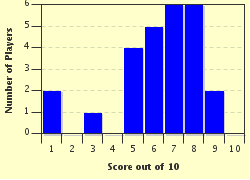Quiz Answer Key and Fun Facts
1. When Europeans began to make their way to South America, they found many different groups of indigenous people living there. Which of the following groups of native Americans are NOT indigenous to Guyana?
2. Located in the northeastern part of South America, Guyana is part of a group of countries that at one time was known as "the Guianas". What does "guiana" mean?
3. Which of the following countries was the first to colonize the modern country called Guyana?
4. Known for ultimately being found guilty of treason and losing his head, who was the first European explorer to describe his travels in the area called Guyana today?
5. After two brief attempts to rule Guyana in the late 1700s and early 1800s, Guyana became a British united colony called British Guiana in 1831. Which of the following commodities formed the economic base of British Guiana at that time?
6. With which neighboring country did Guyana have a long-time land dispute that lasted from 1814-1899?
7. Cuffy is considered today to be one of the national heroes of Guyana. With which of the following events, occurring in 1763, is he associated?
8. Georgetown is the chief port and capital of Guyana today. Which of the following statements regarding its history is TRUE?
9. Guyana has been involved in a dispute with the neighboring country of Suriname for a number of years. Which of the following best describes the source of their disagreement?
10. After the abolition of slavery in the British empire, which of the following groups immigrated to Guyana and took over the jobs of the former slaves on plantations?
Source: Author
ponycargirl
This quiz was reviewed by FunTrivia editor
gtho4 before going online.
Any errors found in FunTrivia content are routinely corrected through our feedback system.

